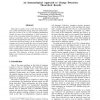Free Online Productivity Tools
i2Speak
i2Symbol
i2OCR
iTex2Img
iWeb2Print
iWeb2Shot
i2Type
iPdf2Split
iPdf2Merge
i2Bopomofo
i2Arabic
i2Style
i2Image
i2PDF
iLatex2Rtf
Sci2ools
CSFW
1996
IEEE
1996
IEEE
An Immunological Approach to Change Detection: Theoretical Results
: This paper examines some of the theoretical foundations of the distributable change detection method introduced by Forrest et al. in [10], including fundamental bounds on some of its parameters. A short overview is given of the reasoning behind this method, its immunological counterpart and its computer implementation. The amount of information that is lost by splitting a data stream into unordered strings can be estimated, and this estimate can be used to guide the choice of string length. A lower bound on the size of the detector set is derived, based on information-theoretic grounds. The principle of holes (undetectable nonself strings) is illustrated, along with a proof of their existence for a large class of matching rules. The influence of holes on the achievable failure rate is discussed, along with guidelines on how to avoid them.
CSFW 1996 | Distributable Change Detection | Forrest Et Al | Security Privacy | Undetectable Nonself Strings |
| Added | 07 Aug 2010 |
| Updated | 07 Aug 2010 |
| Type | Conference |
| Year | 1996 |
| Where | CSFW |
| Authors | Patrik D'haeseleer |
Comments (0)

